Bright pink light-colored flowers/Raicho and Komakusa
Distantly, the craggy peak of Tsurugidake stands out in the pale morning sky, illuminated by the morning sun. Beyond, the Tateyama mountain range can still be seen with a lot of lingering snow. Even though it is the end of July, there is indeed a lot of snow in the northern mountains of the Northern Alps.
Pale, ephemeral pink flowers dot the white terrain that stretches along the ridge of Mount Hakuba. The name “Komakusa” comes from the shape of the long buds, which resemble a horse’s visage. The elegant and dainty Komakusa is also called the “queen of alpine flora,” and is well known to many people as a representative alpine flower.
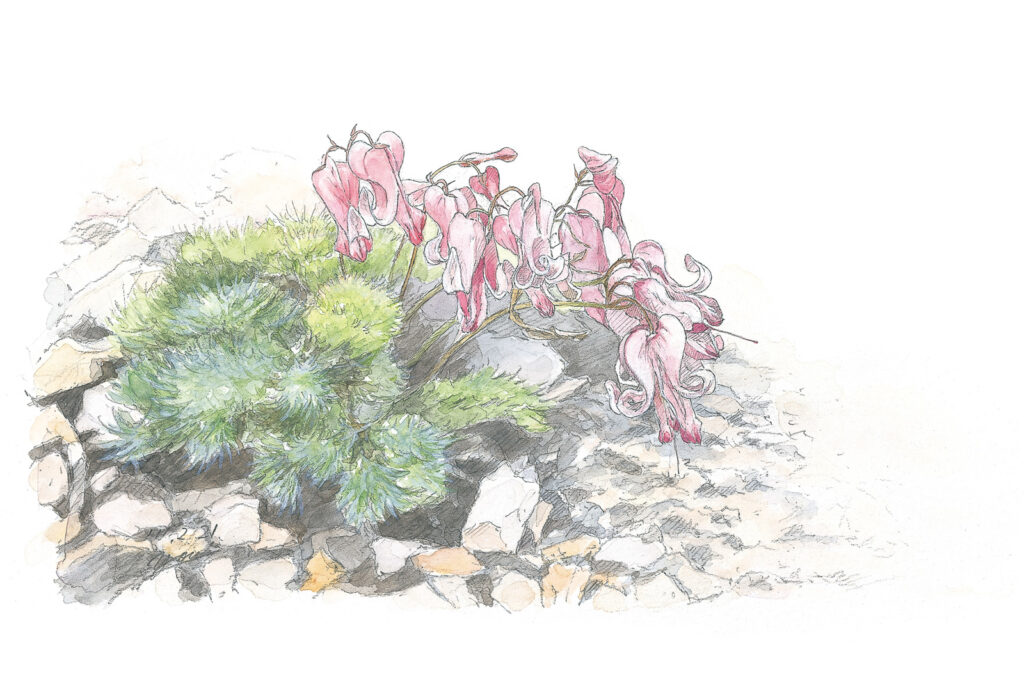
illustration | Yohei Naruse
Hiroshi Yoshida was a landscape painter. Objects, animals, and plants were often depicted not as thematic subjects, but rather as elements of the landscape. This is presumably due to the teachings of Shotaro Koyama of the Fudosha art school which Yoshida entered upon moving to Tokyo at the age of 18: “It is not enough to simply depict the landscape as it is. You should always add something that evokes daily life and living, such as people in the incidental details of the scenery.”
Under a crisp azure summer sky, pure white clouds drifted by, blocking out the strong sunlight. A traverse trail leads to a large, gently sloping ridge. A dry wind blew coolly over the mountainside. The journey was quite pleasant, and I was amazed at the number of flowers that adorned both sides of the mountain path. Geum monopetalum, mountain harebell, Thunberg’s fleabane, Anaphalis alpicola and Komakasa. A plethora of wild flora were in full bloom, as if they had been waiting for summer. It is a veritable flower garden above the clouds, with climbers passing by, admiring the alpine flora.
The alpine flora of the Japanese Alps has always fascinated many people. Hiroshi Yoshida loved the beauty of the mountains, but surprisingly he was not very concerned about alpine flora.
Flower gardens with alpine flora are abundant throughout the Japanese Alps. But they are not as picturesque as the word suggests. I don’t know a great deal about alpine flora, but the flowers of the black lilies and the cornflowers still caught my eye. …(omission) …A flower garden might give the impression of being filled with flowers of strange colors unfamiliar to us in the world below, and on top of that, a different kind of strange butterfly, also unfamiliar to us in the land below, is flying about, but a flower garden is not such a beautiful thing. As I have already mentioned, there are some unusual species of butterflies, but even these are rarely seen at higher elevations. Birds, first and foremost raicho, with occasional glimpses of hawks, swallows and bamboo crows.
Masao Takamura, a fellow artist and friend of Hiroshi, said of the mountain landscape painter Banka Maruyama, who was also a close friend of Hiroshi: “Maruyama-kun is passionate about alpine plants, so his works are not called Japanese-style paintings nor watercolors, but are all about alpine vistas with alpine plants”, and added: “Yoshida-kun is a mountain painter too, but he does not have a bent towards plants or flowers. ‘He is mainly interested in the natural appearance of the mountain peaks and the changes in the cloudbursts on the peaks’.
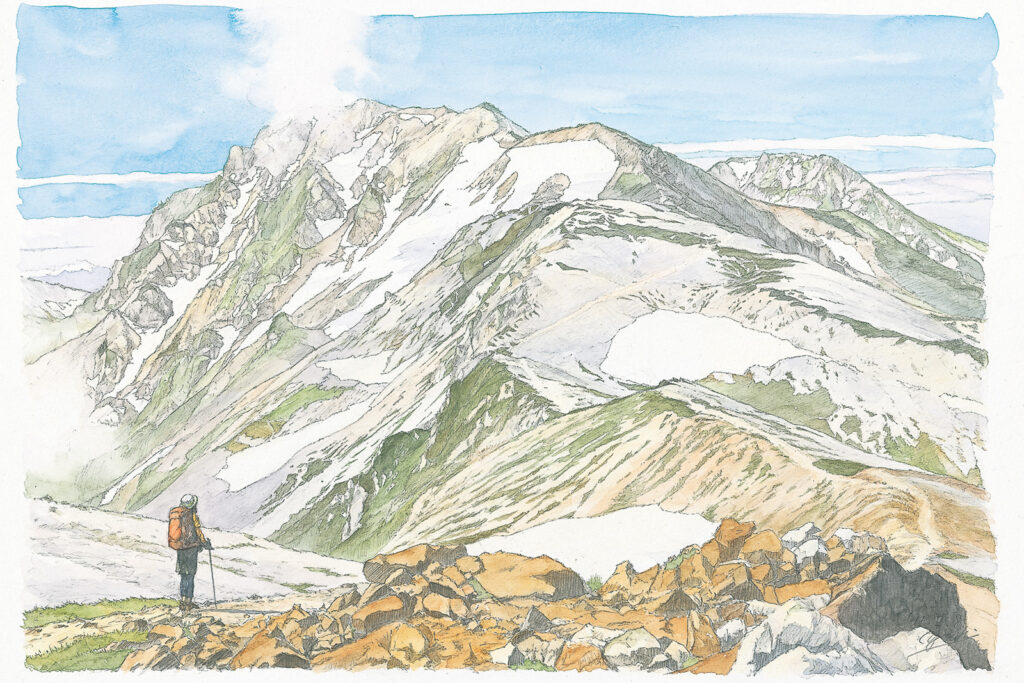
illustration | Yohei Naruse
Although he even wrote a somewhat disparaging description of the flower fields, Hiroshi seems to have had a special affection for the komakusa, which he says adorned “my gaze rather well”.
On that slope, I found the largest komakusa flower I had ever seen. The bright pink, light-colored flowers were clustered together and seemed to float on the white sand. I had always regarded alpine flora as a rarity and not very attractive, but at that moment I was undeniably fascinated by the beauty of the flowers. And even now I am convinced that in terms of beauty, the Komagusa flower is the quintessential alpine flora.
Six of the ‘Twelve subjects of the Japanese Alps’ are stamped in red with a komakusa motif. This suggests that he was strongly attracted to the beauty of komakusa, and probably depicted them in this series of prints as one of the most representative landscapes of the Japanese Alps, together with the alpine raicho.
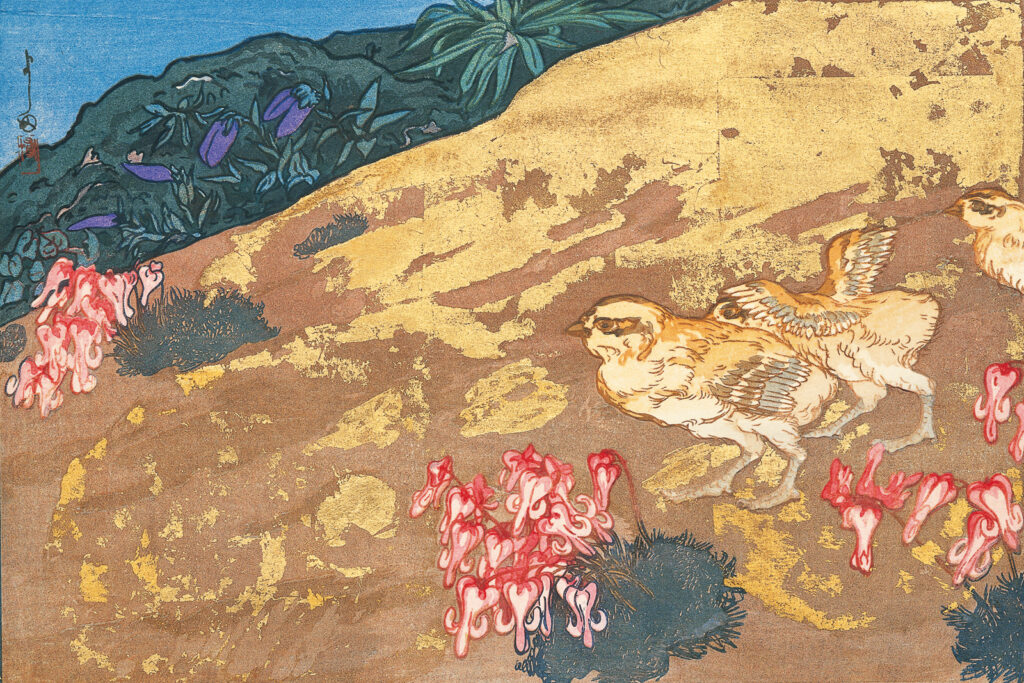
As the dense cloud vapor rose from the east, the area gradually became gray with worsening visibility. There will be thunderstorms today. Raicho, which have long been believed to be birds that call the thunder, often appear before the rains begin. The gully in the gently sloping high pine belt descending from Mt. Korenge to Hakuba Oike is known as ‘Raicho Slope’ due to the abundance of these grouse. At the end of the rainy season, raicho mothers are supposed to have curious chicks in tow, but a cursory look around revealed no sign of them, save for the sound of their shrill calls echoing out of nowhere.
A large body of water was visible beyond the thinning clouds. It is the Hakuba-Oike Pond, perched on a mountain at an altitude of nearly 2,400 meters. Surrounded by bright green slopes, the tranquil surface of the water reflects the gray sky, flanked by white snow banks. The red roof of Hakuba Oike Sanso and the small yellow and green tents can be seen on the shore of the pond.
I arrived at the mountain lodge shortly after noon, pitching my tent in a quiet spot close to the water. On the grassland, where melting snow seeps into the ground, endless colonies of white Geum pentapetalum are swaying in the wind across the water. The wind creates ripples, and the slanting rays of light become grains of light that sparkle and shine. What a tranquil scene!
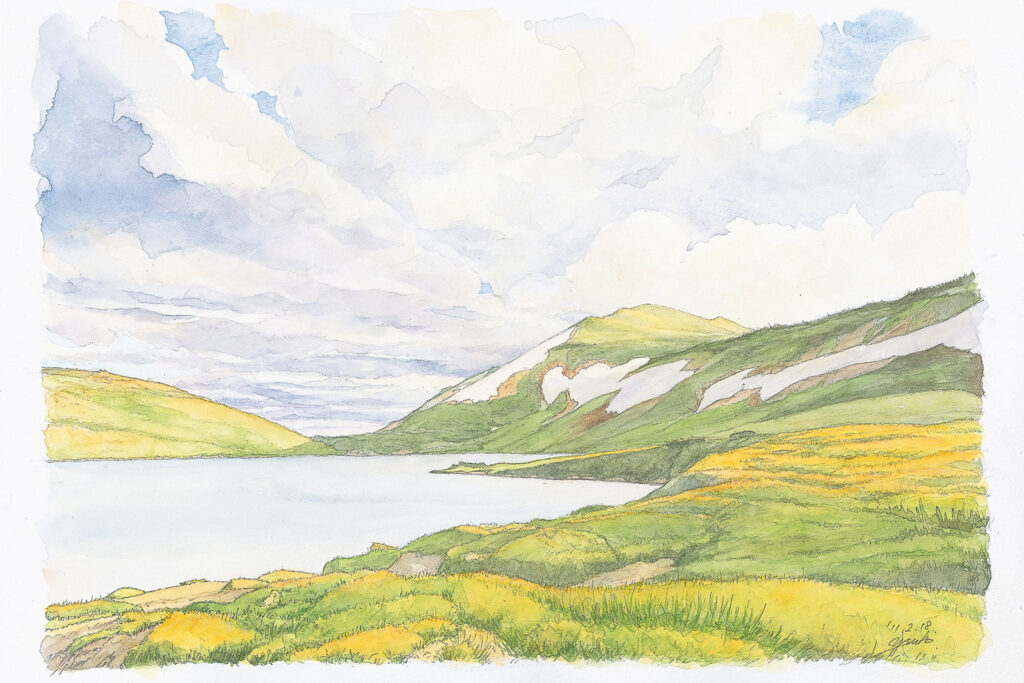
illustration | Yohei Naruse
The Hakuba Oike-Pond is a volcanic lake. It is so quiet that not even fish seem to inhabit it. Sometimes it seems as if black clouds are floating down over the entire surface of the water. At such times, I feel as if a dragon might rise from the water.
So wrote Hiroshi Yoshida. Today, the pond has a mountain lodge and is bustling with people. Back then, the pristine pond must have looked much more mythical, without a single soul.
In the evening, the vapor gradually cleared and the clouds over the pond began to take on a yellowish hue. The next moment, the sun shone slightly to the west through a break in the clouds. The orange glow on the opposite slope gradually became brighter, illuminating the flowers and grasses blooming along the lakeshore, but the sun was already too far to the west to enhance the scenery any further. The wind blowing across the water felt a little stronger.
<PAPERSKY no.35(2011)>
route information
Rising to an elevation of 2,932 meters, Mt Shirouma, is one of the most famous peaks in the Northern Alps and is known as a mountain where komakusa grow in abundance. The best time to see these flowers is from July to August. The ridge line stretching north from the summit is gentle and has no dangerous spots, allowing climbers to enjoy a leisurely and majestic traverse. The hike from Hakuba Sanso to Tsugaike Sanso can usually be done in one day, but the view of Hakuba Oike Pond is spectacular, so staying overnight at Hakuba Oike Sanso will make the trip more rewarding. The snow field remains until late in the day on the way down from Norikura-dake, so be careful not to slip. Take the ropeway and gondola to Tsugaike Kogen Station at the foot of the mountain. There are hot springs in the vicinity to soothe fatigued hikers.
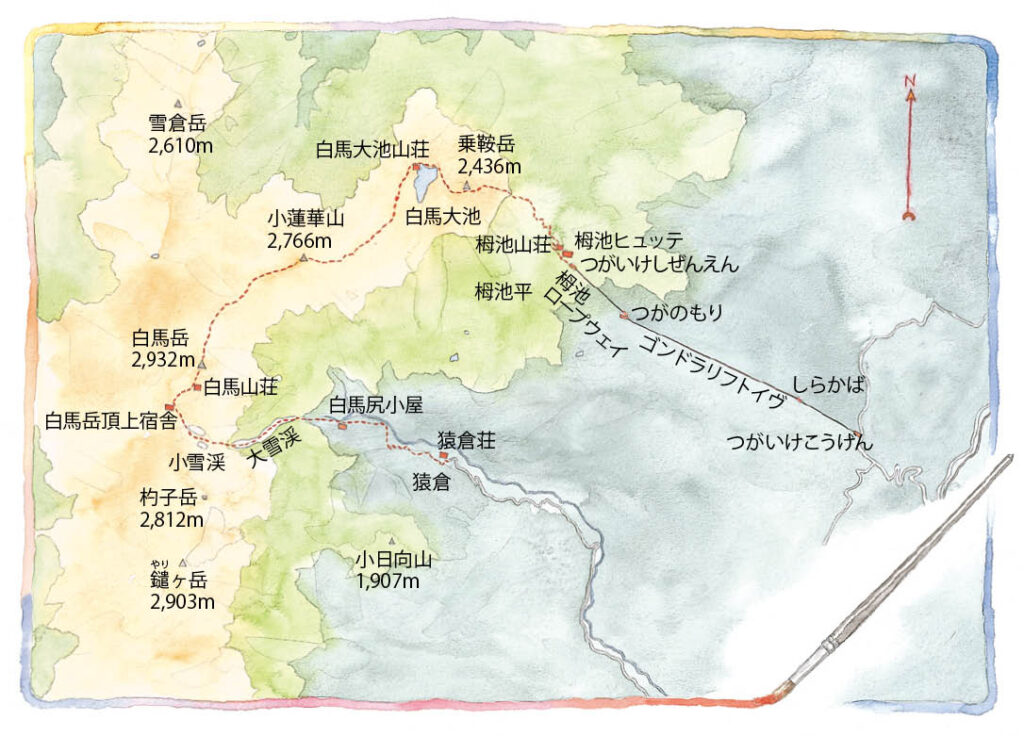
Yohei Naruse
Born in Gifu Prefecture in 1982. Graduated Tsuru University, Graduate School. Following a stint in advertising, he currently works as a freelance writer and illustrator.











